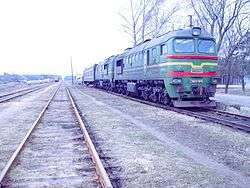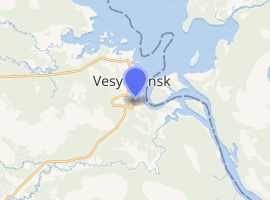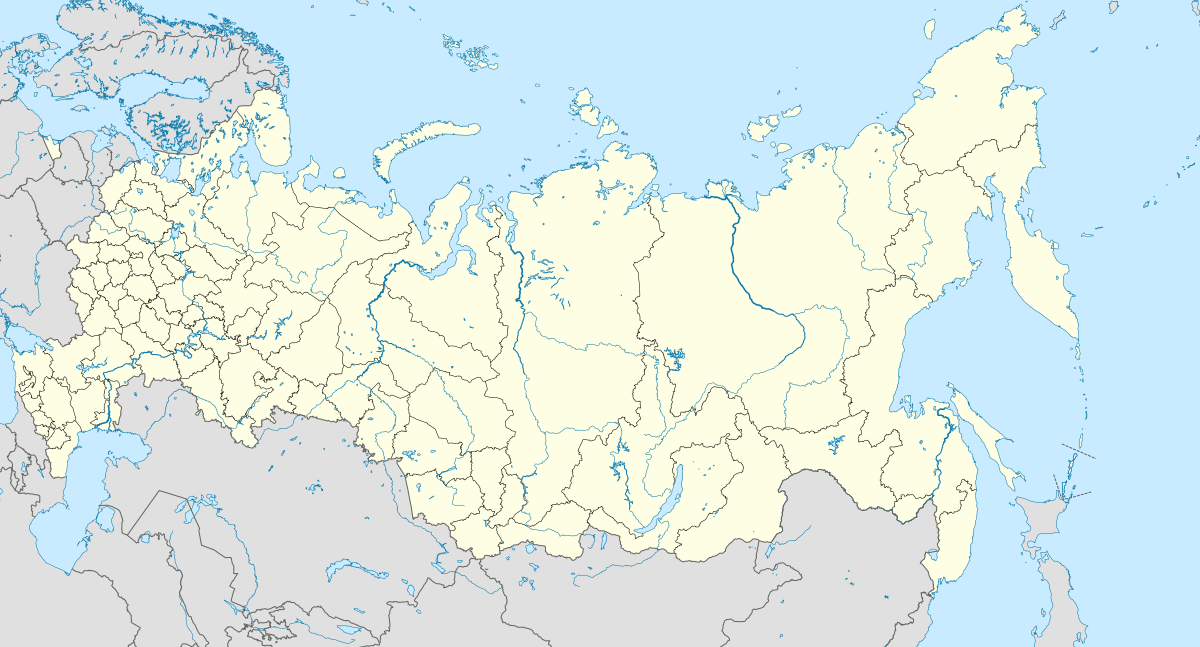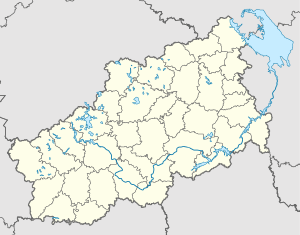Vesyegonsk
Vesyegonsk (Russian: Весьего́нск) is a town and the administrative center of Vesyegonsky District in Tver Oblast, Russia. Population: 7,329 (2010 Census);[5] 8,662 (2002 Census);[11] 9,574 (1989 Census).[12]
Vesyegonsk Весьегонск | |
|---|---|
Town[1] | |
 Vesyegonsk railway station | |
.png) Coat of arms | |
Location of Vesyegonsk 
| |
 Vesyegonsk Location of Vesyegonsk  Vesyegonsk Vesyegonsk (Tver Oblast) | |
| Coordinates: 58°41′N 37°15′E | |
| Country | Russia |
| Federal subject | Tver Oblast[1] |
| Administrative district | Vesyegonsky District[2] |
| Urban settlement | Vesyegonsk[2] |
| First mentioned | 15th century[3] |
| Town status since | December 1953[4] |
| Elevation | 108 m (354 ft) |
| Population | |
| • Total | 7,329 |
| • Estimate (2018)[6] | 6,219 (-15.1%) |
| • Capital of | Vesyegonsky District[7], Vesyegonsk Urban Settlement[2] |
| • Municipal district | Vesyegonsky Municipal District[8] |
| • Urban settlement | Vesyegonsk Urban Settlement[8] |
| • Capital of | Vesyegonsky Municipal District[8], Vesyegonsk Urban Settlement[8] |
| Time zone | UTC+3 (MSK |
| Postal code(s)[10] | 171720, 171721 |
| OKTMO ID | 28610101001 |
The historical part of Vesyegonsk lies under the waters of the Rybinsk Reservoir. It was previously known as Ves Yogonskaya (until 1776).[13]
History
The territory of modern Vesyegonsky District was originally populated by the Ves people, a Finnic tribe; the name of Vesyegonsk derives from the Ves. Vesyegonsk was first mentioned as Ves Yogonskaya in the 15th century.[3] The settlement was located on the Mologa River, which was one of the main waterways from the Volga to the north of Russia. In the 18th century, after the Tikhvin Water System was constructed, Vesyegonsk was on the waterway connecting Moscow with St. Petersburg. However, the Tikhvin Water System eventually decayed and Vesyegonsk's importance declined as well.[13]
In the course of the administrative reform carried out in 1708 by Peter the Great, the territory was included into Ingermanland Governorate (known since 1710 as St. Petersburg Governorate), but in 1727 it was transferred to Moscow Governorate. In 1775, Tver Viceroyalty was formed and in 1776 Vesyegonsky Uyezd was established as a part of Tver Viceroyalty. At the same time, Vesyegonsk was granted town status and became the seat of the uyezd.[13] In 1796, the viceroyalty was transformed into Tver Governorate and the uyezd was abolished. In 1803, Vesyegonsky Uyezd was re-established. On April 25, 1921, Vesyegonsky Uyezd was transferred to newly established Rybinsk Governorate.[4] In February 1923, Rybinsk Governorate was abolished[13] and the uyezd was transferred back to Tver Governorate on February 6, 1923.[4]
On July 12, 1929, the governorates and uyezds were abolished.[4] Vesyegonsky District, with the administrative center in Vesyegonsk, was established within Bezhetsk Okrug of Moscow Oblast.[4] On July 23, 1930, the okrugs were abolished and the districts were directly subordinated to the oblast.[14] On January 29, 1935, Vesyegonsky District was transferred to newly established Kalinin Oblast.[4] In 1939, the construction of the Rybinsk Reservoir started and large areas in the lower course of the Mologa were slated to be submerged under water.[3] Vesyegonsk in particular was to be completely submerged.[3] Due to this, the town was moved 0.5 kilometers (0.31 mi) from the original location[3] and downgraded in status to that of an urban-type settlement;[13] the administrative center of the district was moved to the selo of Ovinishche.[13] On April 26, 1940, Vesyegonsky District was abolished and on March 3, 1949, it was re-established; Vesyegonsk became the administrative center of the district again.[4] In December 1953, Vesyegonsk was once again granted town status.[4]
Administrative and municipal status
Within the framework of administrative divisions, Vesyegonsk serves as the administrative center of Vesyegonsky District.[7] As an administrative division, it is incorporated within Vesyegonsky District as Vesyegonsk Urban Settlement.[2] As a municipal division, this administrative unit also has urban settlement status and is a part of Vesyegonsky Municipal District.[8]
Economy
Industry
There are enterprises of timber and food industries in Vesyegonsk.[15]
Transportation
Vesyegonsk is a terminal railway station on the railway which runs to Ovinishchi. There, it connects to the railway running between Moscow and Mga via Krasny Kholm and Pestovo.
Vesyegonsk is connected by roads with Ustyuzhna and with Tver via Krasny Kholm and Bezhetsk. There are also local roads. There is bus traffic originating from Vesyegonsk.
Culture and recreation
After Vesyegonsk was relocated, only two streets from the original town survived. There are five cultural heritage monuments of local significance in Vesyegonsk. These include the monuments to soldiers fallen in World War II, the tomb of the early Bolshevik, and the ensemble of two churches—the Kazan Church (1811) and the Trinity Church (1868).[16]
Vesyegonsk is home to the Vesyegonsk District Museum, which holds expositions on local history.[17]
References
Notes
- Law #34-ZO
- Law #34-ZO stipulates that the borders of the settlements (administrative-territorial divisions) are identical to the borders of the urban and rural settlements (municipal divisions), and that the borders of the administrative districts are identical to the borders of the municipal districts. Law #21-ZO, which describes the borders and the composition of the municipal formations in Vesyegonsky Municipal District, lists the town of Vesyegonsk as a part and the administrative center of Vesyegonsk Urban Settlement of that district.
- Энциклопедия Города России ["Cities and towns of Russia" Encyclopedia]. Moscow: Большая Российская Энциклопедия. 2003. pp. 69–70. ISBN 5-7107-7399-9.
- Справка об изменениях в административно-территориальном делении Тверской губернии - Калининской области (in Russian). Архивы России. Archived from the original on April 19, 2012. Retrieved August 28, 2014.
- Russian Federal State Statistics Service (2011). "Всероссийская перепись населения 2010 года. Том 1" [2010 All-Russian Population Census, vol. 1]. Всероссийская перепись населения 2010 года [2010 All-Russia Population Census] (in Russian). Federal State Statistics Service.
- "26. Численность постоянного населения Российской Федерации по муниципальным образованиям на 1 января 2018 года". Federal State Statistics Service. Retrieved January 23, 2019.
- Государственный комитет Российской Федерации по статистике. Комитет Российской Федерации по стандартизации, метрологии и сертификации. №ОК 019-95 1 января 1997 г. «Общероссийский классификатор объектов административно-территориального деления. Код 28 210», в ред. изменения №278/2015 от 1 января 2016 г.. (State Statistics Committee of the Russian Federation. Committee of the Russian Federation on Standardization, Metrology, and Certification. #OK 019-95 January 1, 1997 Russian Classification of Objects of Administrative Division (OKATO). Code 28 210, as amended by the Amendment #278/2015 of January 1, 2016. ).
- Law #21-ZO
- "Об исчислении времени". Официальный интернет-портал правовой информации (in Russian). June 3, 2011. Retrieved January 19, 2019.
- Почта России. Информационно-вычислительный центр ОАСУ РПО. (Russian Post). Поиск объектов почтовой связи (Postal Objects Search) (in Russian)
- Russian Federal State Statistics Service (May 21, 2004). "Численность населения России, субъектов Российской Федерации в составе федеральных округов, районов, городских поселений, сельских населённых пунктов – районных центров и сельских населённых пунктов с населением 3 тысячи и более человек" [Population of Russia, Its Federal Districts, Federal Subjects, Districts, Urban Localities, Rural Localities—Administrative Centers, and Rural Localities with Population of Over 3,000] (XLS). Всероссийская перепись населения 2002 года [All-Russia Population Census of 2002] (in Russian).
- "Всесоюзная перепись населения 1989 г. Численность наличного населения союзных и автономных республик, автономных областей и округов, краёв, областей, районов, городских поселений и сёл-райцентров" [All Union Population Census of 1989: Present Population of Union and Autonomous Republics, Autonomous Oblasts and Okrugs, Krais, Oblasts, Districts, Urban Settlements, and Villages Serving as District Administrative Centers]. Всесоюзная перепись населения 1989 года [All-Union Population Census of 1989] (in Russian). Институт демографии Национального исследовательского университета: Высшая школа экономики [Institute of Demography at the National Research University: Higher School of Economics]. 1989 – via Demoscope Weekly.
- Наша история (in Russian). Муниципальное образование Весьегонский район. Retrieved August 28, 2014.
- Snytko et al., p. 87
- Инвестиционная привлекательность района (in Russian). Муниципальное образование Весьегонский район. Retrieved July 9, 2013.
- Памятники истории и культуры народов Российской Федерации (in Russian). Russian Ministry of Culture. Retrieved June 2, 2016.
- Весьегонский краеведческий музей (in Russian). Российская сеть культурного наследия. Retrieved July 9, 2013.
Sources
- Законодательное Собрание Тверской области. Закон №34-ЗО от 17 апреля 2006 г. «Об административно-территориальном устройстве Тверской области», в ред. Закона №66-ЗО от 1 октября 2014 г. «О внесении изменения в статью 18 Закона Тверской области "Об административно-территориальном устройстве Тверской области"». Вступил в силу со дня официального опубликования. Опубликован: "Тверские ведомости", №17 (специальный выпуск), 19 апреля 2006 г. (Legislative Assembly of Tver Oblast. Law #34-ZO of April 17, 2006 On the Administrative-Territorial Structure of Tver Oblast, as amended by the Law #66-ZO of October 1, 2014 On Amending Article 18 of the Law of Tver Oblast "On the Administrative-Territorial Structure of Tver Oblast". Effective as of the official publication date.).
- Законодательное Собрание Тверской области. Закон №21-ЗО от 28 февраля 2005 г. «Об установлении границ муниципальных образований, входящих в состав территории муниципального образования Тверской области "Весьегонский район", и наделении их статусом городского, сельского поселения», в ред. Закона №52-ЗО от 6 июня 2006 г. «О внесении изменений в отдельные Законы Тверской области, регулирующие вопросы установления границ муниципальных образований Тверской области». Вступил в силу со дня официального опубликования. Опубликован: "Тверские ведомости", №10, 11–17 марта 2005 г. (Legislative Assembly of Tver Oblast. Law #21-ZO of February 28, 2005 On Establishing the Borders of the Municipal Formations Comprised by the Territory of the Municipal Formation of "Vesyegonsky District" and on Granting Them the Status of Urban, Rural Settlements, as amended by the Law #52-ZO of June 6, 2006 On Amending Various Laws of Tver Oblast on Regulating the Issues of Establishing the Borders of the Municipal Formations of Tver Oblast. Effective as of the day of the official publication.).
- Законодательное Собрание Тверской области. Закон №4-ЗО от 18 января 2005 г. «Об установлении границ муниципальных образований Тверской области и наделении их статусом городских округов, муниципальных районов», в ред. Закона №65-ЗО от 24 июля 2012 г. «О внесении изменения в статью 2 Закона Тверской области "Об установлении границ муниципальных образований Тверской области и наделении их статусом городских округов, муниципальных районов"». Вступил в силу через десять дней после официального опубликования. Опубликован: "Тверские ведомости", №3, 21–27 января 2005 г. (Legislative Assembly of Tver Oblast. Law #4-ZO of January 18, 2005 On Establishing the Borders of the Municipal Formations of Tver Oblast and on Granting Them the Status of Urban Okrugs, Municipal Districts, as amended by the Law #65-ZO of July 24, 2012 On Amending Article 2 of the Law of Tver Oblast "On Establishing the Borders of the Municipal Formations of Tver Oblast and on Granting Them the Status of Urban Okrugs, Municipal Districts". Effective as of the day which is ten days after the official publication.).
- Снытко, О. В.; et al. (2009). С. Д. Трифонов; Т. Б. Чуйкова; Л. В. Федина; А. Э. Дубоносова (eds.). Административно-территориальное деление Новгородской губернии и области 1727-1995 гг. Справочник. [Administrative-Territorial Division of Novgorod Governorate and Oblast in 1727–1995. A Reference.] (PDF) (in Russian). Saint Petersburg. Retrieved August 19, 2014.